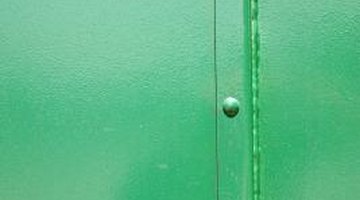How to Get Imperfections Out of Nason Stage 1 Paint
Painting imperfections are flaws that result from the painting process. These imperfections could be as simple as a small paint run resulting from too much paint applied to a section of the surface, to an orange peel-like surface caused by allowing too much time to pass between paint coats. Using single stage paint like the Nason brand from Dupont can help reduce some of the imperfections, by reducing the number of total paint coats needed, due to having the clear coat mixed in with the topcoat. However, an imperfection doesn't mean having to strip the paint and starting over. With a bit of sanding and polishing you can get rid of the flaw to create a smoothly consistent surface with no signs of the imperfection.

-
Wait 12 hours or overnight after applying the single stage Nason paint for the paint to dry somewhat before attempting to remove any imperfections from the painted surface.
-
Examine the painted surface to locate painting imperfections. These imperfections include any area where the paint is not smoothly placed on the surface. Common problems include: runs in the paint where too much paint was applied and excess drips down the surface; sags, where a heavy application of paint droops down the surface, creating a slight ridge beneath a thin patch of paint; or brush and roller marks resulting from brushing or rolling the paint onto the surface.
-
Put on a NIOSH approved respirator to keep from inhaling paint particles during the surface repair process.
-
Remove imperfections using 1500-grit wet/dry sandpaper saturated in a bucket of water. Sand down the imperfections, smoothing the surface of the imperfectly applied paint until it's even with the surrounding painted surface. Use small, gentle circular motions with the sandpaper, keeping it wet at all times to avoid creating sanding lines in the surface. Wipe the sanded surface with a tack cloth to remove any sanded paint.
-
Place a small pool of finishing compound onto the center of a #0000 steel wool pad. Buff the painted surface with the compound to remove the small sanding lines created by the fine-grit sandpaper. As with the sandpaper, use a small circular pattern to apply the compound to avoid creating swirl lines or sanding row lines.
-
Apply a thin layer of finishing polish on the paint to create a slight gloss using a variable speed buffer. Set the buffer to operate at a speed between 1700 and 2000 rpm and attach a foam pad for polishing. Go over the surface of the paint with the pad and polish until you achieve the appropriate glossiness from the paint.
References
Resources
Tips
- If you sand through the paint to the primer beneath, repaint the affected area, allow the paint to dry, then sand the area smooth with the surrounding surface before buffing.
Writer Bio
Larry Simmons is a freelance writer and expert in the fusion of computer technology and business. He has a B.S. in economics, an M.S. in information systems, an M.S. in communications technology, as well as significant work towards an M.B.A. in finance. He's published several hundred articles with Demand Studios.
Photo Credits
- Jupiterimages/Photos.com/Getty Images
More Articles



